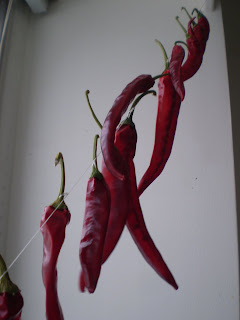skip to main |
skip to sidebar
Some left-over ham got mixed with swiss cheese and mustard and baked in a pie crust.

 I picked up a monstrous hock from K&K Foodliner. It was one of the cheapest cuts of meat I have ever bought: about $6.50 for 1.7kg.
I picked up a monstrous hock from K&K Foodliner. It was one of the cheapest cuts of meat I have ever bought: about $6.50 for 1.7kg.
The plan was to convert this raw hock into a smoked ham hock, and then to use that to make a broth.
I put the hock in a simple brine solution for about a week, then smoked it over cherry wood.
I simmered my smoked ham hock for about an hour. The flavour was unbelievable. Obviously it tasted like pork, but it was so smoky it verged on campfire. If it were any warmer outside, or if I were serving the Queen high tea, I would have diluted it. But today it seemed right.
Next I used the broth to cook my vegetables. I actually used up the last of the carrots and potatoes from the fall harvest at Tipi Creek, (though we still have about a dozen squash and countless bags of frozen vegetables). Even after an aborted attempt at making sauerkraut, we also had lots of cabbage heads rolling about our refrigerator.
To recap, that was carrots, potatoes, and cabbage simmer in a ham hock broth. Garnished with shredded ham and celery leaves. Served with mustard and bread. A good cold-weather meal.

The term “barbecue” is used pretty loosely around these parts. Most often it refers to an outdoor grill, but I have also had “barbecued” items in restaurants that haven't been anywhere near an outdoor grill. In fact, these items, usually ribs or pulled-pork, have been braised or even stewed in an acidic solution called "barbecue sauce".
True barbecue is pork that has smoked at low temperature for several hours. The home of true barbecue is the American south, notably the Carolinas and Tennessee. When I say "true", I'm not arguing about the origin of the word or the antiquity of the practices, although I suspect that Southern barbecue would win on those fronts, too. I mean that the quality of the resulting product is infinitely superior with true barbecue. It is unlike any meat I have had before: it is transcendent.
The difference in taste is obvious. Complex, aromatic smoke is the base. Barbecue sauce is added towards the end of cooking, for a little acidity and sweetness. The real surprise was the texture. Food that is stewed in barbecue sauce is touted as "tender", but is actually just mushy. Food cooked low and slow and dry are tender, but they still have texture and bite.
In the southern states, there are barbecue restaurants. They have smokehouses where they cook pork ribs and beef briskets for eight hours. People line up to eat at these places. They literally go through tons of meat every day. They sell out of product every night. Occasionally one of these places will be featured on a Food Network show like Diners, Drive-In, and Dives. To my knowledge they just don't exist in Canada. Luckily you can do it at home.
Over the past two weeks I have barbecued twice. The first was with pork shoulder from Trowlesworthy Farms. The second was today, with grocery store side ribs, in the photo above.
Required Reading:
- Jeffrey Steingarten's essay "Going Whole Hog", from The Man Who Ate Everything. Does a good job describing the mania for barbecue in the southern states.
- Michael Ruhlman's recipes for Pulled Pork and Carolina Barbecue Sauce in his book Charcuterie.
 Or, How to Make Things Uncomfortable for a Microbe.
Or, How to Make Things Uncomfortable for a Microbe.
A simple start: dehydration. All life needs water, so removing the moisture from food makes it inhospitable to microbes. Some items can simply be air-dried. One week in July Lisa bought a whole bag of hot peppers from Doef's, then strung them together with unflavoured dental floss and hung them in our kitchen. The skin has become paper thing and brittle, and when held to the light you can see the shadows of the seeds. It's a simple preserving method that requires almost no work and keeps us in pepper heat all winter long.
You could probably also naturally air-dry fruit, but partway through the summer a family of fruit flies moved into our house, so we had to give our drying method a little boost. We had a couple gallons of saskatoons and tried a batch in the oven and a batch in a food dehydrator that Lisa and Judy found at a garage sale (one of several fantastic finds this summer.) Both turned out great and make a tasty addition to our infinite supply of granola.

 I picked up a monstrous hock from K&K Foodliner. It was one of the cheapest cuts of meat I have ever bought: about $6.50 for 1.7kg.
I picked up a monstrous hock from K&K Foodliner. It was one of the cheapest cuts of meat I have ever bought: about $6.50 for 1.7kg.
 Or, How to Make Things Uncomfortable for a Microbe.
Or, How to Make Things Uncomfortable for a Microbe.